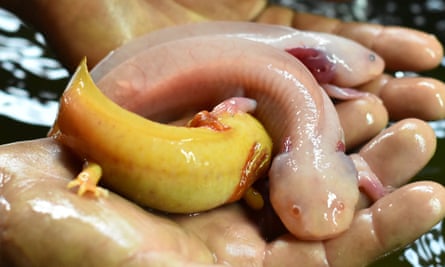Ecologists from Mexico’s National Autonomous University on Friday relaunched a fundraising campaign to bolster conservation efforts for axolotls, a native, endangered fish-like type of salamander.
The campaign, called Adoptaxolotl, asks people for as little as 600 pesos (about $35) to virtually adopt one of the tiny “water monsters”. Virtual adoption comes with live updates on your axolotl’s health. For less money, donors can buy a virtual dinner for one of the creatures, which are relatively popular pets in the US.
In Mexican axolotls’ main habitat, the population density has plummeted 99.5% in under two decades, according to scientists behind the fundraiser.
Last year’s Adoptaxolotl campaign raised just more than 450,000 pesos ($26,300) towards an experimental captive-breeding program and efforts to restore habitat in the ancient Aztec canals of Xochimilco, a southern borough of Mexico City.
Still, there are not enough resources for thorough research, said Alejandro Calzada, an ecologist surveying less well-known species of axolotls for the government’s environment department.
“We lack big monitoring of all the streams in Mexico City,” let alone the whole country, said Calzada, who leads a team of nine researchers. “For this large area it is not enough.”

Despite the creature’s recent rise to popularity, almost all 18 species of axolotl in Mexico remain critically endangered, threatened by encroaching water pollution, a deadly amphibian fungus and non-native rainbow trout.
While scientists could once find 6,000 axolotls on average per square kilometer in Mexico, there are now only 36, according to the National Autonomous University’s latest census. A more recent international study found less than 1,000 Mexican axolotls left in the wild.
Luis Zambrano González, one of the university’s scientists announcing the fundraiser, told the Associated Press he hopes to begin a new census (the first since 2014) in March.
“There is no more time for Xochimilco,” said Zambrano. “The invasion” of pollution is very strong: soccer fields, floating dens. It is very sad.”
Without data on the number and distribution of different axolotl species in Mexico, it is hard to know how long the creatures have left, and where to prioritize what resources are available.
“What I know is that we have to work urgently,” Calzada said.
after newsletter promotion
Axolotls have grown into a cultural icon in Mexico for their unique, slimy appearance and uncanny ability to regrow limbs. Scientists in labs around the world think this healing power could hold the secret to tissue repair and even cancer recovery.
In the past, government conservation programs have largely focused on the most popular species: the Mexican axolotl, found in Xochimilco. But other species can be found across the country, from tiny streams in the valley of Mexico to the northern Sonora desert.
Mexico City’s expanding urbanization has damaged the water quality of the canals, while in lakes around the capital rainbow trout, which escape from farms, can displace axolotls and eat their food.
Calzada said his team was increasingly finding axolotls dead from chytrid fungus, a skin-eating disease causing catastrophic amphibian die-offs from Europe to Australia.
While academics rely on donations, and Calzada’s team turns to a corps of volunteers, the Mexican government recently approved an 11% funding cut for its environment department.
Over its six-year term, the administration of president Andrés Manuel López Obrador will have given 35% less money to the country’s environment department than its predecessor, according to an analysis of Mexico’s 2024 budget.
